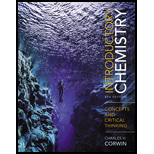
Concept explainers
(a)
Interpretation:
The given Celsius temperature is to be expressed in Kelvin units.
Concept introduction:
Temperature can be measured in Kelvin scale, Celsius scale and Fahrenheit scale. Celsius is commonly used measurement unit for temperature. Kelvin is the SI unit of temperature. The absolute zero on the Kelvin scale is the temperature at which all the thermal motion ceases.
(b)
Interpretation:
The given Celsius temperature is to be expressed in Kelvin units.
Concept introduction:
Temperature can be measured in Kelvin scale, Celsius scale and Fahrenheit scale. Celsius is commonly used measurement unit for temperature. Kelvin is the SI unit of temperature. The absolute zero on the Kelvin scale is the temperature at which all the thermal motion ceases.
Want to see the full answer?
Check out a sample textbook solution
Chapter 2 Solutions
Introductory Chemistry: Concepts and Critical Thinking Plus MasteringChemistry with eText -- Access Card Package
- So which amongst these central atoms would be polyatomics?arrow_forwardWhich of the following vocabulary words defines the energy due to motion? A.Heat B.Potential Energy C.Kinetic Energy D.Temperaturearrow_forwardWhat is the normal melting point of sulfur (in degrees Celsius)? Express answer in the NEAREST WHOLE NUMBERarrow_forward
- Suppose that instead of using the cylindrical rod of Example 1-2 to prepare a 1.000 kgmass we were to use a solid spherical ball of copper What must be the radius of this ball?arrow_forwardWhat properties distinguish solids from liquids? Liquids from gases? Solids from gases?arrow_forwardA bicycle accelerates from 5 miles per hour to 15 miles per hour. Does its energy increase or decrease? Is the change in potential energy or kinetic energy?arrow_forward
- The freshly polished brass cylinder in the picture below is a mixture of copper and zinc. Is the cylinder a homogenous or heterogeneous substance?arrow_forwardWhat is the relationship between the Celsius and centigrade temperature scales?arrow_forwardHow many units between the freezing point and boiling point of water do two of the three temperature scales named above have in common?arrow_forward
 Living By Chemistry: First Edition TextbookChemistryISBN:9781559539418Author:Angelica StacyPublisher:MAC HIGHER
Living By Chemistry: First Edition TextbookChemistryISBN:9781559539418Author:Angelica StacyPublisher:MAC HIGHER Chemistry for Today: General, Organic, and Bioche...ChemistryISBN:9781305960060Author:Spencer L. Seager, Michael R. Slabaugh, Maren S. HansenPublisher:Cengage Learning
Chemistry for Today: General, Organic, and Bioche...ChemistryISBN:9781305960060Author:Spencer L. Seager, Michael R. Slabaugh, Maren S. HansenPublisher:Cengage Learning World of Chemistry, 3rd editionChemistryISBN:9781133109655Author:Steven S. Zumdahl, Susan L. Zumdahl, Donald J. DeCostePublisher:Brooks / Cole / Cengage LearningChemistry: Matter and ChangeChemistryISBN:9780078746376Author:Dinah Zike, Laurel Dingrando, Nicholas Hainen, Cheryl WistromPublisher:Glencoe/McGraw-Hill School Pub Co
World of Chemistry, 3rd editionChemistryISBN:9781133109655Author:Steven S. Zumdahl, Susan L. Zumdahl, Donald J. DeCostePublisher:Brooks / Cole / Cengage LearningChemistry: Matter and ChangeChemistryISBN:9780078746376Author:Dinah Zike, Laurel Dingrando, Nicholas Hainen, Cheryl WistromPublisher:Glencoe/McGraw-Hill School Pub Co Introductory Chemistry: An Active Learning Approa...ChemistryISBN:9781305079250Author:Mark S. Cracolice, Ed PetersPublisher:Cengage Learning
Introductory Chemistry: An Active Learning Approa...ChemistryISBN:9781305079250Author:Mark S. Cracolice, Ed PetersPublisher:Cengage Learning





